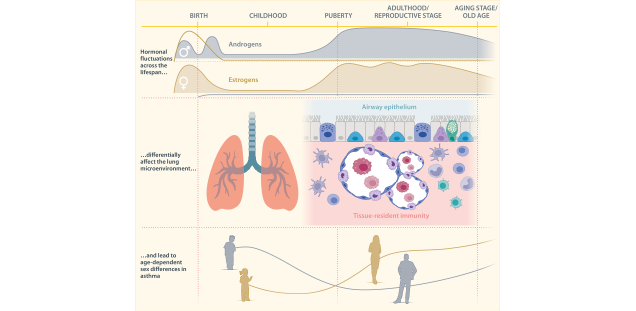Interactions between lung microenvironment and immune responses in the sex-specific manifestation of asthma
Asthma is a chronic inflammatory airway disease with an increasing prevalence worldwide. Striking age-dependent sex-specific differences have been described in asthma prevalence and manifestation. While boys are mostly affected until puberty, this bias reverses in adolescence and adulthood, when sex hormones begin to surge and females become more affected. Additionally, we and others have previously reported that the lung microenvironment and specifically the respiratory epithelium play an integral role in the observed sex bias in childhood asthma. These observations suggest that both sex hormones and the lung microenvironment contribute to the asthma-related sex bias. Apart from the respiratory epithelium, immune cells permanently residing in the lung, the so-called tissue-resident immunity, are also essential parts of the lung microenvironment and may be implicated in this context. Despite mounting evidence highlighting sex differences in circulating immunity, little is known about potential sex-specific traits of tissue-resident immunity and their potential alterations across the lifespan. We have recently identified a sexual dimorphism in both innate and adaptive tissue resident immunity of the naïve mouse lung, which was established and further intensified with age progression. Of note, androgens were identified as a key determinant of the observed sex bias. The sexual dimorphism of lung-resident immunity and the role of androgens in this context may explain the sex bias observed in asthma manifestation. Importantly, given the age-related fluctuations in sex hormone levels, age-dependent sex differences in lung tissue-resident immunity may potentially contribute to the shifting sex bias in asthma manifestation. In the present project, we aim to investigate the role of lung microenvironment in the age-dependent sexual dimorphism of asthma across the lifespan. Our expected findings will improve our understanding of the mechanisms underlying sex-specific differences in asthma, and set the basis for the design of tailored therapeutic approaches that take the existing sexual dimorphism of the lung microenvironment into account.
PROJECT-RELATED PUBLICATIONS
Zazara DE, Giannou O, Schepanski S, Pagenkemper M, Giannou AD, Pincus M, Belios I, Bonn S, Muntau AC, Hecher K, Diemert A#, Arck PC#. (2024)
Fetal lung growth predicts the risk for early-life respiratory infections and childhood asthma.
World J Pediatr I 20:481-495
read more
Giannou AD#, Ohm B#, Zazara DE, Lücke J, Zhang T, Sabihi M, Seeger P, Oh J, Grotelüschen R, Busch P, Mann O, Hackert T, Izbicki JR, Yamada Y, Huber S#, Jungraithmayr W#. (2023)
Protocol for orthotopic single-lung transplantation in mice as a tool for lung metastasis studies.
STAR Protoc I 4:102701
read more
Zazara DE, Belios I, Lücke J, Zhang T, Giannou AD. (2020)
Tissue-resident immunity in the lung: a first-line defense at the environmental interface.
Semin Immunopathol I 44:827-854
read more
Zazara DE, Wegmann M, Giannou AD, Hierweger AM, Alawi M, Thiele K, Huber S, Pincus M, Muntau AC, Solano ME#, Arck PC.# (2020)
A prenatally disrupted airway epithelium orchestrates the fetal origin of asthma in mice.
J Allergy Clin Immunol I 145:1641-1654
read more
Zazara DE, Perani CV, Solano ME, Arck PC. (2018)
Prenatal stress challenge impairs fetal lung development and asthma severity sex-specifically in mice.
J Reprod Immunol I 125:100-105
read more
*: equally contributing first authors
#: equally contributing senior authors




